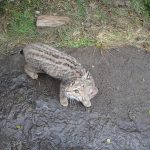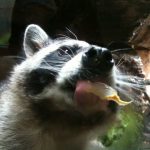Blog
A Closer Look at Enrichment: Touch
Welcome to the third installment of CuriOdyssey’s “A Closer Look at Enrichment” series, that describes how our keepers think about an animal’s sense of “touch” when making enrichment. Animals use their sense of touch everyday as they explore their environment, search for food, and find shelter. Different textures also appeal to different animals. Snakes that like to burrow will often seek fine substrate like dirt or sand. While peregrine falcons (Falco peregrines) are comfortable perching on rocks, other raptors such as hawks prefer perching on branches. CuriOdyssey keepers work hard to recreate the tactile experiences our animals might have in the wild. This includes collecting plant clippings for their enclosures, commonly referred to as “browse.”
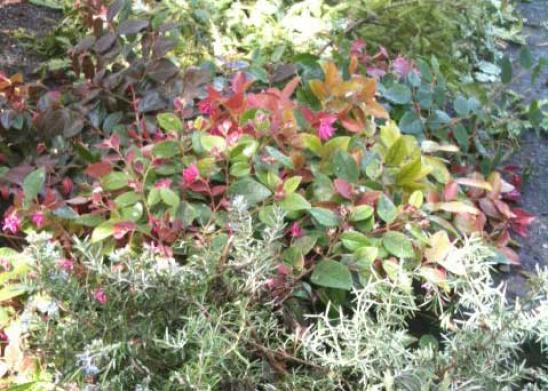
Placing browse in an enclosure encourages our animals to express the natural behaviors they would if they encountered plants in the wild. Our bobcats (Lynx rufus) and North American porcupine (Erithizon dorsatum) enjoy chewing on browse, so keepers make an extra effort to give them edible plants such as blackwood acacia (Acacia melanoxylon), Fremont cottonwood (Populus fremontii) and arroyo willow (Salix lasiolepis). Browse also serves as nesting material for birds in our aviaries and adds texture to our dioramas for animals like the western toads and banana slugs.

In addition to browse, keepers recently introduced to our animals a stringy, woody material called excelsior. This can also be used as nesting material for our birds and is often placed in our otters’ den as bedding.

Another item that is commonly used at CuriOdyssey to stimulate an animal’s sense of touch is ice. Although our California-native animals would be less likely to encounter ice in the wild, zookeepers around the world use it for animal enrichment because it has a unique texture and temperature. Keepers may freeze food in a container of water to make an “ice treat,” or simply give our animals lots of ice cubes to play with. Our North American river otters (Lontra canadensis) have learned to carry ice treats into their pond and swim with the ice until it melts to retrieve the food inside. They also seem to enjoy pushing ice cubes around with their noses and into their pond.

Other objects such as cardboard boxes and newspaper have an interesting texture and can be transformed into shredding material on raptor perches or foraging toys. For example, our raptors hardly pass up the chance to shred newspaper that is wrapped around their perches. Cutting holes in a cardboard box, filling it with crumpled newspaper, a little bit of kibble and then sealing the box makes for an interesting puzzle feeder. This type of feeder encourages our animals to be active, curious and even problem-solve to get their food. For an additional challenge, keepers may create hanging piñatas with a special food item so our animals have to jump to get it!
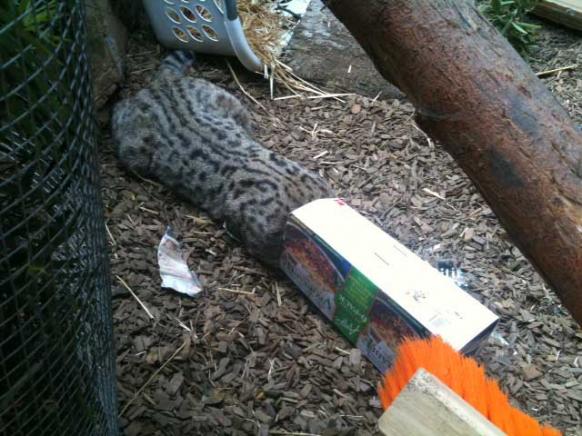
There are numerous tactile enrichment possibilities, and keepers often combine several different textures into one enrichment item. Hay, moss, mulch, gravel, dried leaves and pine cones can be placed in trays with food to serve as a rooting box. Our raptors appear to enjoy the feeling of being misted with cool water on warm days as they perch on a log or daisy mat. They often take the opportunity to stretch out their wings and preen. On any given day at CuriOdyssey, visitors can see large branches, platforms, hammocks, tires, tunnels and other furniture in all of our large exhibits. Keepers will move this furniture daily around the exhibits and distribute toys such as balls and stuffed animals. Orange streamers that were used as decoration for Bobcat Day last week were given to all of our education reptiles and invertebrates. The keepers think our California mountain king snake (Lampropeltis zonata), Scarlet, found it to be a stimulating texture – don’t you agree?
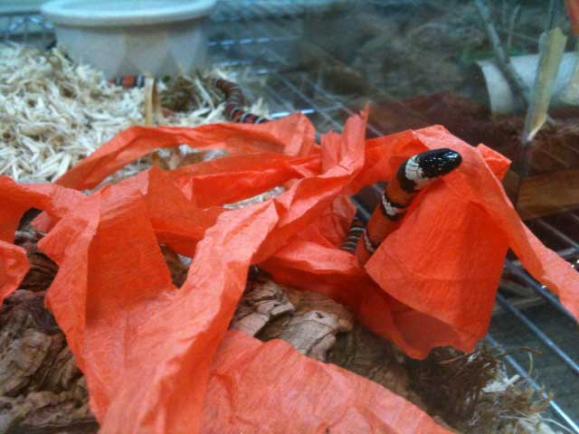
It’s hard to imagine what life would be like without having a sense of touch. All materials have texture. Even food has texture! It is important to CuriOdyssey that our animals live stimulating, enriching lives. Be sure to check back soon for the next posting of this blog series, which will describe how keepers utilize our animals sense of “sight” when making enrichment.
– post and photos by Rachael Tom, Animal Keeper
Join the CuriOdyssey Community
LOCATION
1651 Coyote Point Drive
San Mateo, CA 94401
Ohlone Land Acknowledgement
650-342-7755
info@curiodyssey.org
CuriOdyssey is a 501(c)(3) non-profit, Tax ID 94-1262434



